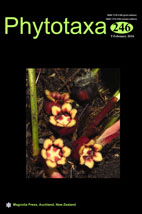Abstract
The subtribal delimitation and relationship of Old World Cymbidiinae and Eulophiinae within Cymbidieae remain unresolved. Relationships among all subtribes of Cymbidieae (Orchidaceae: Epidendroideae) were estimated using the coding genes psaB, rbcL, matK, ycf1 and Xdh for 103 taxa. The results indicate that most of the clades are successively sister to the grade of clades representing previously recognized subtribes, and Dipodium does not belong in its previous classification of Cymbidiinae and Eulophiinae. Instead, this genus represents an additional isolated lineage.

